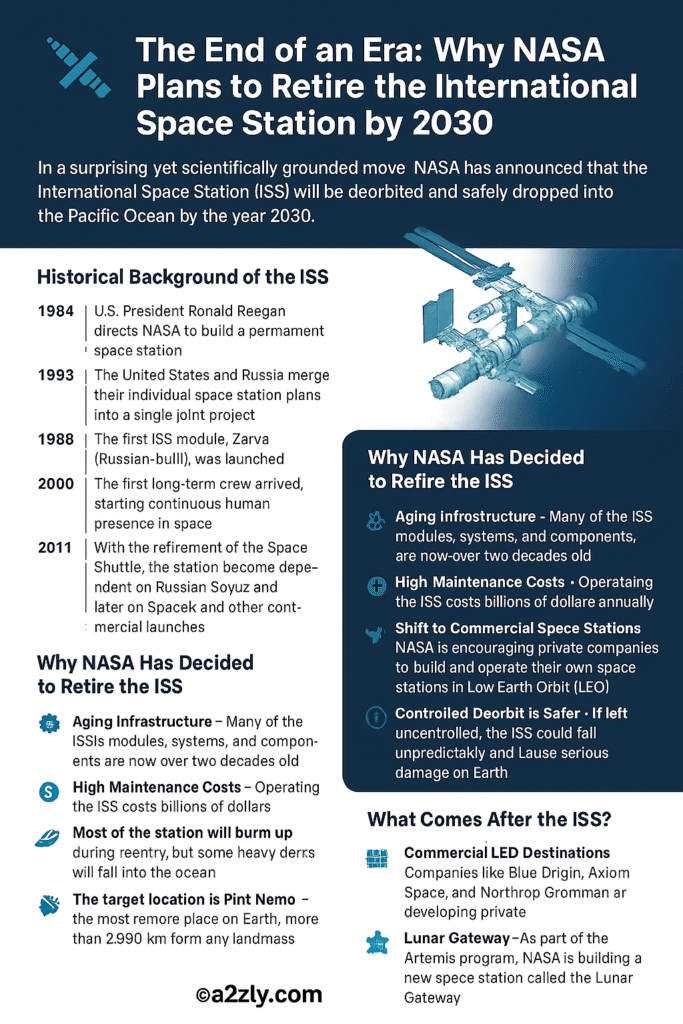
🛰️ Introduction
NASA has announced that the International Space Station (ISS) will be deorbited and safely guided into the Pacific Ocean by 2030. This marks the end of one of humanity’s most iconic space projects — a symbol of scientific achievement and global cooperation — and the dawn of a new era focused on commercial space stations and deep-space exploration.
Why deorbit such a monumental achievement? Let’s explore the ISS’s journey, current state, and the future of space exploration.
🕰️ Historical Background of the ISS
The ISS stands as one of the greatest collaborative engineering feats in human history, born out of both competition and cooperation.
Key Milestones
- 1984: U.S. President Ronald Reagan directs NASA to build a permanent space station.
- 1993: The U.S. and Russia merge their individual projects into one — the ISS.
- 1998: Launch of the first module, Zarya (Russian-built).
- 2000: Arrival of the first long-term crew, beginning over two decades of continuous human presence in space.
- 2011: Retirement of the Space Shuttle, with resupply handled by Russian Soyuz and later SpaceX and other commercial providers.
Over time, astronauts from 26 countries have lived and worked aboard the ISS, supported by a partnership of five space agencies:
NASA (USA), Roscosmos (Russia), ESA (Europe), JAXA (Japan), and CSA (Canada).
Initially designed for 15 years, the ISS has surpassed 25 years in service.
🧬 Importance and Achievements of the ISS
The ISS has been more than just a spacecraft — it has been a laboratory, observatory, and diplomatic bridge.
Notable Contributions:
- Scientific Research: Experiments in zero gravity across physics, biology, astronomy, and Earth science.
- Medical Insights: Studying the effects of long-term spaceflight on the human body.
- Technology Testing: Trialing systems for Moon and Mars missions.
- Global Inspiration: Engaging millions of students and fostering STEM education worldwide.
It has also stood as a rare example of peaceful, sustained cooperation even during periods of geopolitical tension.
⚠️ Why NASA is Retiring the ISS
After decades in orbit, several factors make retirement inevitable:
- Aging Infrastructure
- Components and modules are over two decades old.
- Issues like structural fatigue, air leaks, and increased maintenance are becoming more frequent.
- Beyond 2030, ensuring astronaut safety would be increasingly challenging.
- High Maintenance Costs
- Operating the ISS costs billions annually.
- NASA aims to redirect funds toward Artemis lunar missions and future Mars exploration.
- Shift to Commercial Space Stations
- Private companies are developing next-generation stations for Low Earth Orbit (LEO).
- These will be more cost-efficient and open to broader commercial use.
- Controlled Deorbit Safety
- Without intervention, the ISS could reenter unpredictably.
- A controlled descent to the remote South Pacific “Point Nemo” — the “spacecraft graveyard” — minimizes risk.
🌊 The Deorbiting Process
Around 2030–2031, NASA will carry out a controlled deorbit:
- A specialized tug spacecraft will lower the ISS’s orbit.
- The station will begin its controlled descent into Earth’s atmosphere.
- Most of the structure will burn up during reentry.
- Surviving debris will splash down harmlessly in Point Nemo, over 2,600 km from any land.
This process echoes the safe disposal of Russia’s Mir space station in 2001.
🚀 Life After the ISS
NASA’s strategy for the post-ISS era centers on expanding human presence in space through new models:
- Commercial LEO Destinations
- Companies like Axiom Space, Blue Origin, and Northrop Grumman are building private space stations.
- NASA will act as a paying customer rather than owner, reducing operational costs.
- Lunar Gateway
- A small space station orbiting the Moon, part of the Artemis program.
- Supports lunar exploration and serves as a stepping stone to Mars.
- Deep Space Exploration
- Freed from ISS maintenance costs, NASA can invest in missions that push humanity beyond Earth’s orbit.
🌠 Conclusion: A Dignified Farewell, a Bold Future
For over 25 years, the ISS has been a beacon of human ingenuity, diplomacy, and discovery. While its retirement will be bittersweet, it’s a necessary step toward the next chapter of space exploration.
By guiding the ISS to a safe and honorable end, NASA isn’t closing a door — it’s opening new ones: to the Moon, to Mars, and perhaps one day, to the stars.

